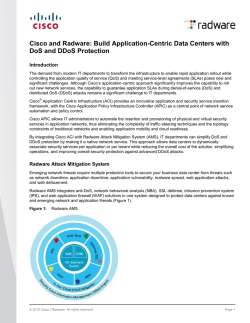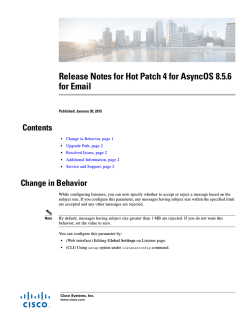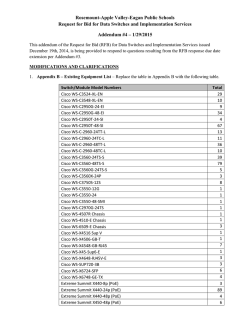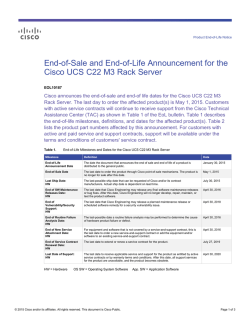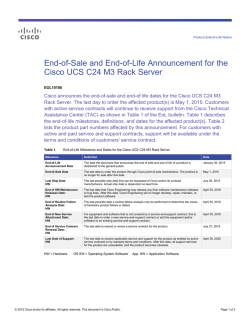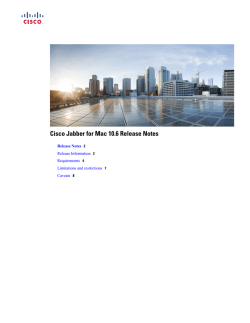
Enable Application Delivery and SLA Assurance in
Cisco and Radware: Enable Application Delivery and SLA Assurance in Application-Centric Infrastructure Introduction The demand from modern IT departments to transform the infrastructure to enable rapid application rollout while controlling the application quality of experience (QoE) and meeting service-level agreements (SLAs) poses new and significant challenges. Although Cisco’s application-centric approach significantly improves the capability to roll out new network services, the capability to continuously deliver applications while helping guarantee SLAs remains a significant challenge to IT departments. ® Cisco Application Centric Infrastructure (ACI) integrates the Radware service fabric to bring customers the benefits of deploying ACI as a dynamic and automated service-aware data center infrastructure while continuously delivering applications without adversely affecting application SLAs. Regardless of the location of application or the form factor chosen to deploy Radware services (physical, virtual, or cloud), the solution makes highly specific application delivery and security services available to any application while automating application delivery functions throughout the application lifecycle. Applications can be moved, scaled out, and dynamically spun up while retaining the associated services without any location-specific constraints. Application policies can be optimized to best address the changing SLA requirements of applications because Cisco ACI provides Radware services with the capability to apply resources and policies anywhere in the network. Additionally, while traffic classification remains a function of the Radware service, application traffic steering-based forwarding can dynamically be offloaded to Cisco ACI. By integrating Cisco ACI and the Radware service fabric through the Cisco Application Policy Infrastructure Controller (APIC), IT departments can deliver an agile data center network without compromising application SLAs and while continuously delivering applications. About Cisco ACI Cisco ACI in the data center is a holistic architecture with centralized automation and policy-based application profiles. ACI delivers software flexibility with the scalability of hardware performance. The main characteristics of ACI include: Simplified automation using an application-centric policy model Centralized visibility with end-to-end real-time application health monitoring Open software flexibility for development and operations (DevOps) team and ecosystem partner integration Scalable performance and secure multitenancy in hardware The future of networking with ACI is a network that is deployed, monitored, and managed in a way that supports DevOps and rapid application change. Cisco ACI achieves this by reducing complexity and providing a common policy framework that can automate the provisioning and management of resources. © 2015 Cisco | Radware. All rights reserved. Page 1 Challenges With applications becoming critical to the success of any business, organizations are seeking to use their IT infrastructure to accelerate application development while focusing more on business differentiation and less on infrastructure management. At the same time, the need for resilient application delivery in cloud environments is increasing, too. To help ensure that SLAs are met and deliver applications over a dynamic IT infrastructure, organizations need to address a number of challenges: Decouple services from the physical network location of the applications: Up until now, network services have been attached to network ports, with traffic to these network ports predefined by network engineers. The process of adding new applications has typically been coupled with a follow-up process in which network and application policies are designed to provide adequate services to these applications. In a world in which applications are added, scaled out, and moved dynamically throughout the data center, this approach is no longer acceptable. Selectively apply policies and services to different applications: Because of the manual process involved in building applications and in associating and configuring network services to match the requirements of these applications, the common practice has been to custom design services as part of the overall application introduction process. In an environment in which applications are dynamically deployed, the need to manually configure services undermines the benefits of dynamic infrastructure. Change and optimize application delivery services throughout the application lifecycle: With the ticket-system-based process typically used by organizations to request service changes from IT departments, application owners typically experience a time lag between when a request is issued and when applications are updated and service changes made. Any operation that involves manual changes will impede the overall process of orchestrated application changes in automated environments. The joint solution composed of Cisco ACI and Radware Alteon Application Delivery Controller (ADC) Fabric addresses these challenges, enabling IT managers to extract greater value from their ACI deployments. Radware and Cisco Joint Solution Overview Cisco APIC automates the provisioning and configuration of Radware service engines for application delivery and security. It also intelligently offloads service-related Layer 4 functions to the network by using Cisco ACI to insert Radware service functions into application service chains. Using the Radware service fabric, which the APIC controls, the various Radware services are supplied with telemetry information from the network to assess application behavior and optimize existing Radware service resources or bring up additional resources as required in the service chains. Figure 1 shows the logical placement of the various Radware elements in Cisco ACI. © 2015 Cisco | Radware. All rights reserved. Page 2 Figure 1: Radware Alteon and Cisco ACI Cisco ACI can simplify some Radware services to accelerate application lifecycle-related operations: Cisco ACI can be programmed to distribute traffic across multiple Radware resources deployed across the ACI network. Different ADC resources are associated with specific ACI service chains so that each service chain has sufficient resources and so that traffic is forwarded appropriately. Radware resources can be dynamically provisioned and deprovisioned according to the service scale requirements. The APIC uses information about network topology to properly configure Radware Alteon Virtual Appliance (VA) instances that are provisioned. The steering function is enabled throughout the ACI through continuous synchronization of network traffic forwarding policies between Alteon VAs that perform new session traffic classification and dynamically associating and disassociating traffic flows with existing and newly created service chains. Radware services are integrated with Cisco ACI by implementing the Radware device package for Cisco APIC. The Radware device package is a software plug-in, developed by Radware in compliance with APIC guidelines. It is the gateway for all Radware service provisioning and configuration workflows. The APCI controls the Radware services, selectively associating resources that are located across the entire ACI fabric with specific APIC service chains as specified in application policies. Additionally, as a result of the communication between the Radware services with the APIC, the services continuously evaluate the state of business applications and optimize application delivery policies and network forwarding paths accordingly. Together, Cisco ACI and Radware services provide organizations with a dynamic network that can both help meet SLAs and significantly simplify the process of introducing new applications. © 2015 Cisco | Radware. All rights reserved. Page 3 Solution Benefits The joint Radware and Cisco solution offers the following unique benefits: Excellent SLA assurance solution for dynamic networks: Radware’s market-leading next-generation ADC solution delivers real-time application visibility and acceleration and powers dynamic Cisco ACI environments with the capability to uncompromisingly deploy business-critical applications while maintaining SLAs. Application-centric networking: Because of the highly automated capabilities and the programmable nature of Cisco ACI, the joint solution reduces the operational overhead associated with application upgrades and the introduction of new applications and presents an application-centric network. Dynamic, scalable multitenant service infrastructure: By using the telemetry information that can be pulled from the APIC and by dynamically provisioning ADC resources and programming service chains, organizations can dynamically scale their service infrastructure to match the evolving requirements of their applications and clients with little human intervention. Cost effective and ultra-scalable traffic steering: By using the smart traffic classification capabilities of Alteon ADC and the rapid programmability of the Cisco ACI network, routine traffic forwarding rules can be programmed for the network. This feature relieves the ADC from having to perform basic traffic forwarding functions and having to scale the overall steering capabilities for the entire network. Flexible service policy management: Because of the highly programmable nature of Cisco APIC and the capability to selectively associate service chains with specific applications and data flows, the joint solution provides greater flexibility to apply application delivery policies to different applications, far exceeding the flexibility of traditional network-based ADCs. Conclusion With the advances in network automation becoming available with Cisco ACI, and the ever growing requirements to run business-critical applications in the data center network, flexibility is more important than ever. Radware services enable organizations to make the jump to ACI more safely and with a clearer path to the benefits of ACI. The joint Cisco ACI and Radware service based solution offers the most advanced resource orchestration, traffic distribution, application visibility, security, and optimization capabilities on the market, ultimately helping meet SLAs for applications running on the ACI network. For More Information To learn more about Cisco ACI, visit http://cisco.com/go/aci. To learn more about Radware, visit http://www.radware.com. © 2015 Cisco | Radware. All rights reserved. Page 4 © 2015 Cisco and/or its affiliates. All rights reserved. Cisco and the Cisco logo are trademarks or registered trademarks of Cisco and/or its affiliates in the U.S. and other countries. To view a list of Cisco trademarks, go to this URL: www.cisco.com/go/trademarks. Third-party trademarks mentioned are the property of their respective owners. The use of the word partner does not imply a partnership relationship between Cisco and any other company. (1110R) ©2015 Radware Ltd. All rights reserved. Radware and all other Radware product and service names are registered trademarks or trademarks of Radware in the U.S. and other countries. All other trademarks and names are property of their respective owners. C22-733710-00 © 2015 Cisco | Radware. All rights reserved. 01/15 Page 5
© Copyright 2025
